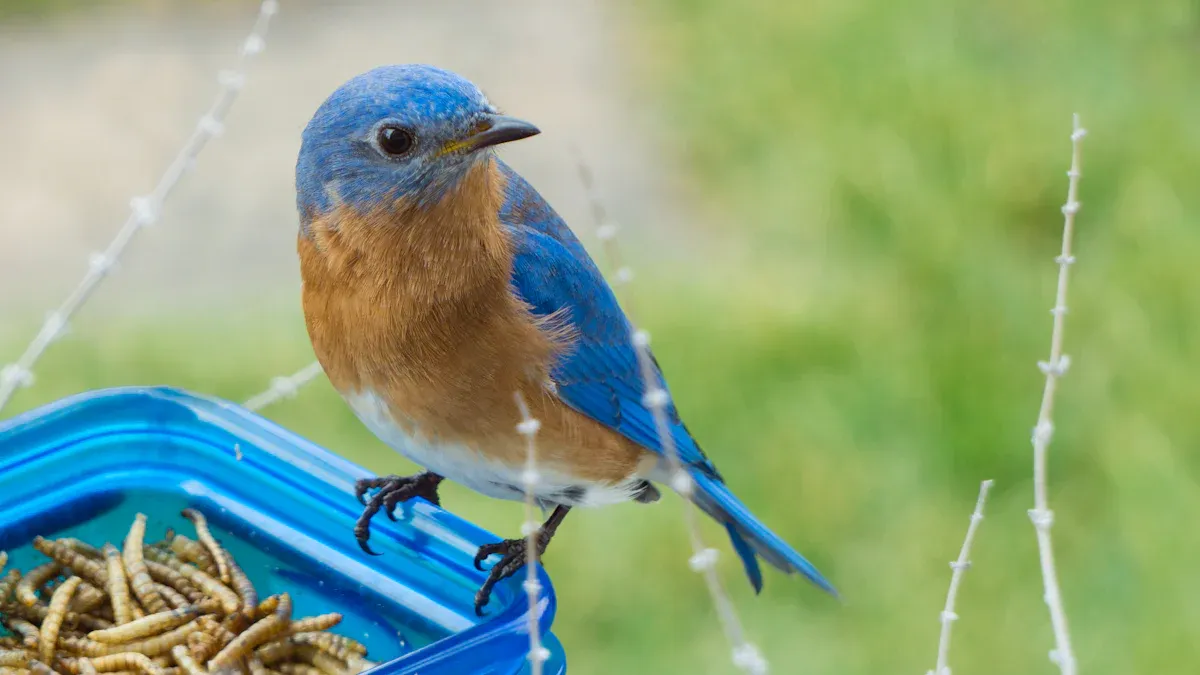
Mealworms for wild birds give backyard visitors a protein boost that supports their health. Birds love this tasty treat, especially during tough seasons. Studies show that birds eating mealworms gain more body mass and energy. Many species flock to feeders for this nutritious snack, making birdwatching more exciting.
Key Takeaways
- Mealworms provide wild birds with high protein and essential nutrients that support strong feathers, healthy immune systems, and successful breeding.
- Dried mealworms are easy to store and handle, offer complete nutrition, and attract many bird species, making feeding time more enjoyable and effective.
- Using mealworms during breeding, molting, and cold seasons helps birds gain energy and improve their health, leading to more active and vibrant backyard visitors.
Nutritional Benefits of Mealworms for Wild Birds
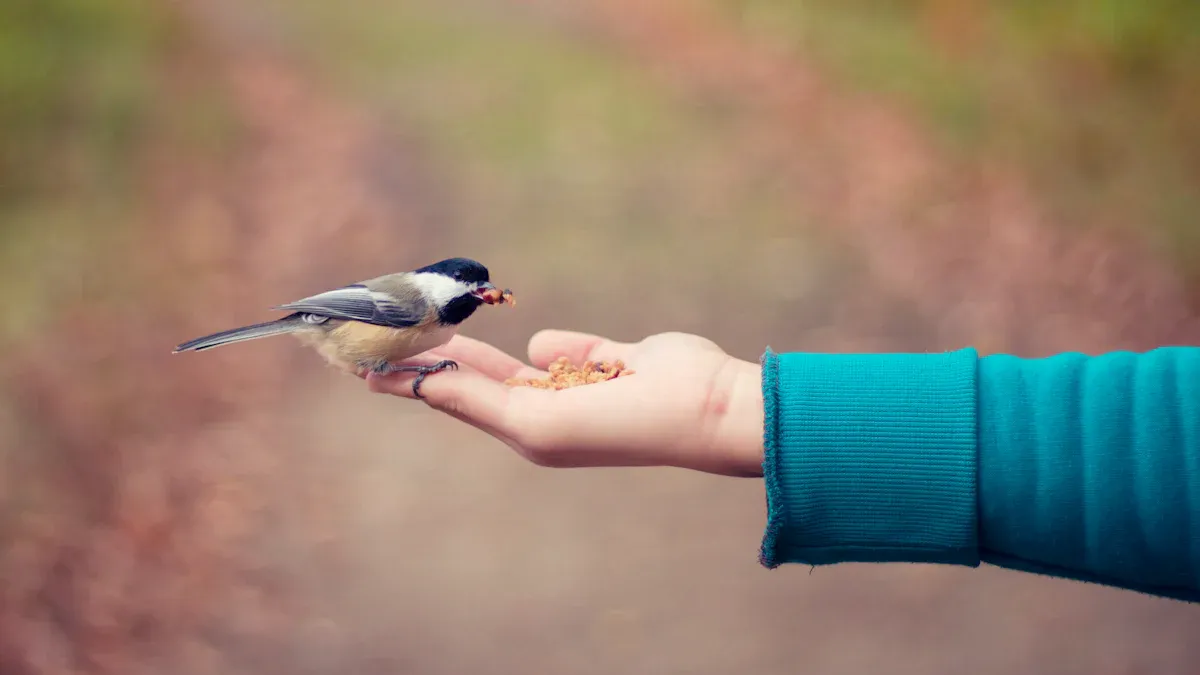
High Protein and Essential Nutrients
Mealworms for wild birds deliver a powerful punch of nutrition. These tiny larvae contain a minimum of 52.8% crude protein and 24.7% crude fat. They also offer essential minerals like calcium, phosphorus, sodium, manganese, and zinc. Birds need these nutrients for strong feathers, healthy immune systems, and successful egg production.
A scientific study found that mealworm larvae can have protein content ranging from 36.3% to 74.1% on a dry matter basis. Essential amino acids make up a big part of this protein, which helps birds grow and stay healthy. Even when mealworms eat a low-protein diet, they still keep high protein levels. This makes them a reliable food source for wild birds all year long.
Dpat Dried Mealworms are 100% natural and packed with protein, vitamins, and high-grade edible oils. They make a high-energy treat that supports the health of wild birds, reptiles, fish, and even sugar gliders. Many backyard bird lovers notice that their feathered friends look healthier and more active after adding mealworms to their diet.
Tip: Birds need extra protein during cold weather, breeding, and molting. Mealworms help them meet these needs with ease.
Why Mealworms Outshine Other Bird Foods
Not all bird foods are created equal. Mealworms for wild birds stand out because of their high protein and complete amino acid profile. When compared to other common bird foods, mealworms hold their own or even come out on top.
| Protein Source | Crude Protein (CP) Content (%) | Notes on Measurement and Adjustment |
|---|---|---|
| Mealworm (Tenebrio molitor larvae) | Average: 52.4 (Range: 47.0 – 60.2) | Measured by combustion (Dumas), Kjeldahl, Randall, elemental analysis methods |
| Soybean Meal (SBM) | 49.4 | Conventional bird feed protein source |
| Fishmeal | 67.5 | Higher protein benchmark |
| Mealworm (adjusted with nitrogen-to-protein conversion factor kp=5.41) | Average: 47.2 (Range: 43.9 – 51.0) | Corrected for chitin overestimation, comparable to SBM |
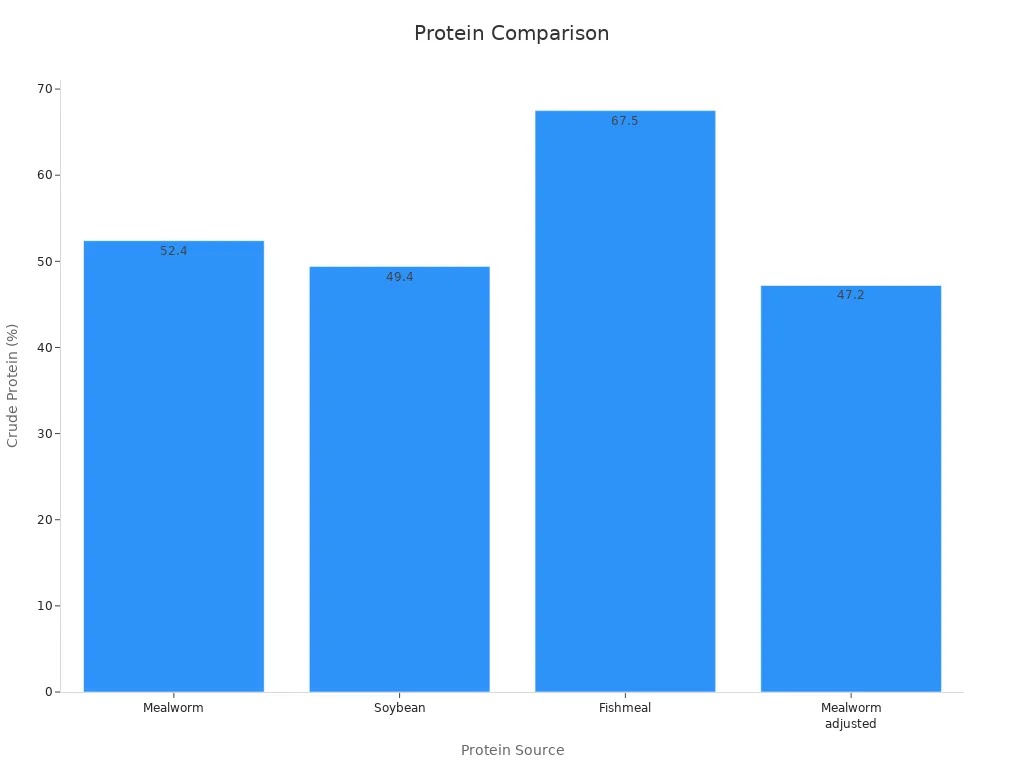
Mealworms also provide all the essential amino acids birds need. For example, insects like mealworms have high levels of lysine, methionine, and arginine. These amino acids are sometimes missing or low in seeds and fruits. The table below shows how mealworms compare to other foods:
| Amino Acid | Hermit Thrush Requirement | White-throated Sparrow Requirement | Amino Acid Content in Insects (e.g., Mealworms) | Amino Acid Content in Seeds | Amino Acid Content in Fruits |
|---|---|---|---|---|---|
| Lysine | 20.02 | 19.95 | High, generally meets requirements | Likely sufficient | Inadequate |
| Methionine | 12.3 | 10.85 | High, generally meets requirements | Likely insufficient | Inadequate |
| Arginine | 18.07 | 34.5 | High, generally meets requirements | Likely sufficient | Inadequate |
Dried mealworms also contain healthy fats, including omega-3 and omega-6 fatty acids. These fats help birds keep their energy up and support brain and heart health. Unlike many seeds, mealworms offer a complete package of nutrients that wild birds crave.
Supporting Birds During Breeding and Molting
Feeding mealworms for wild birds can make a big difference during breeding and molting seasons. Birds need more protein and energy when they lay eggs, raise chicks, or grow new feathers. Studies show that birds who eat mealworms start breeding earlier and have more successful broods. For example, wild wheatears given mealworms produced more chicks and had higher fledging success than those without extra food.
| Aspect | Evidence Summary |
|---|---|
| Food supplementation method | Mealworms provided in feeders accessible only to wheatears; video confirmed target pairs consumed ~88% of mealworms daily (~23.5 g). |
| Breeding timing | Supplemented pairs initiated first clutches earlier than controls. |
| Number of broods | Supplemented pairs were more likely to have second broods; males sometimes had simultaneous broods. |
| Reproductive output | Increased overall reproductive success, including higher fledging success and more breeding attempts. |
| Control comparisons | Control pairs rarely had second broods, even if breeding early, indicating food availability (mealworm consumption) was key. |
During molting, birds replace old feathers with new ones. This process takes a lot of energy and nutrients. Field studies on wild juncos and skylarks found that birds eating mealworms gained more body mass and fat. These birds also showed better immune responses and higher energy levels during the stressful molting period.
| Aspect | Details |
|---|---|
| Species | Wild dark-eyed juncos |
| Study period | Winter 2009 (Jan-Feb), with captive feeding from late Feb to early Mar |
| Diet (ad libitum group) | Mixture including mealworms, millet, sunflower hearts, orange slice, suet |
| Measurements | Body mass, fat scores (0-5 scale), wing length, blood samples for sexing and isotopes |
| Statistical outcomes | Ad libitum birds gained mass (avg +0.84g), fat scores increased; restricted birds lost mass and fat |
Adding Dpat Dried Mealworms to your feeders gives wild birds the boost they need to thrive during these demanding times. Many bird lovers notice more vibrant plumage and increased activity at their feeders when mealworms are part of the menu.
How to Offer Mealworms for Wild Birds
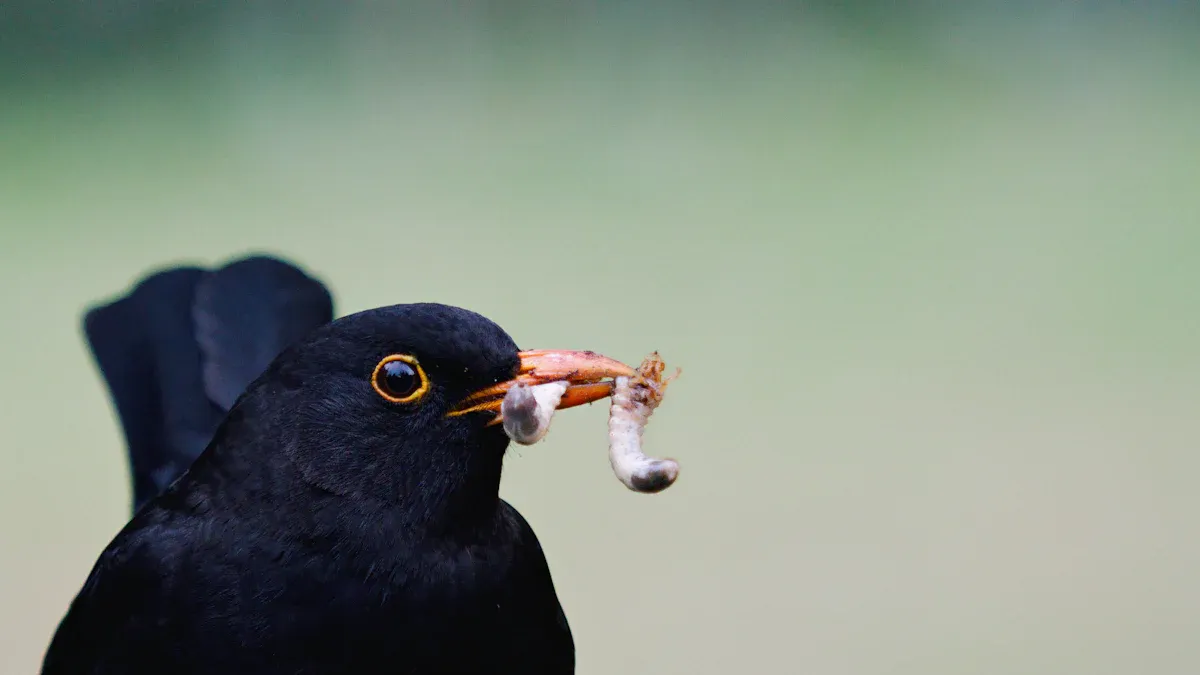
Live vs. Dried Mealworms: Which Is Best?
Bird lovers often wonder if live or dried mealworms work better for wild birds. Both forms have their own benefits. Live mealworms move around and can trigger a bird’s natural hunting instincts. Some birds find them irresistible. Dried mealworms, like Dpat Dried Mealworms, offer the same nutrition but are much easier to store and handle. They do not crawl away, so they stay put in feeders.
Observational surveys show that the form of mealworm can affect how often birds visit feeders. For example, a study on Palestine sunbirds found that parents visited nests more often when they received a liquidized mealworm solution compared to just sugar water. The birds worked harder to feed their chicks when the food quality improved. This suggests that birds notice the difference in mealworm form and respond with more feeding effort.
Safety and nutrition matter, too. Many case studies on poultry show that dried mealworm meal is safe and effective as a feed ingredient. The table below highlights some of these findings:
| Poultry Type | Inclusion Level in Diet | Observed Effects | Reference |
|---|---|---|---|
| Broilers | 75% and 100% | No significant difference in performance | [58] |
| Cobb broiler | 5%, 7.5%, 10% | Improved performance and meat quality | [60] |
| Ross 308 broiler | 20% | Improved meat quality | [61] |
| Ross 708 broiler | 5% | Improved performance and cecal microflora | [62] |
| Hy-line brown hens | 3% | Improved performance and blood biochemistry | [73] |
| White Leghorn hens | 5%, 7.5% | Improved performance and egg quality | [75] |
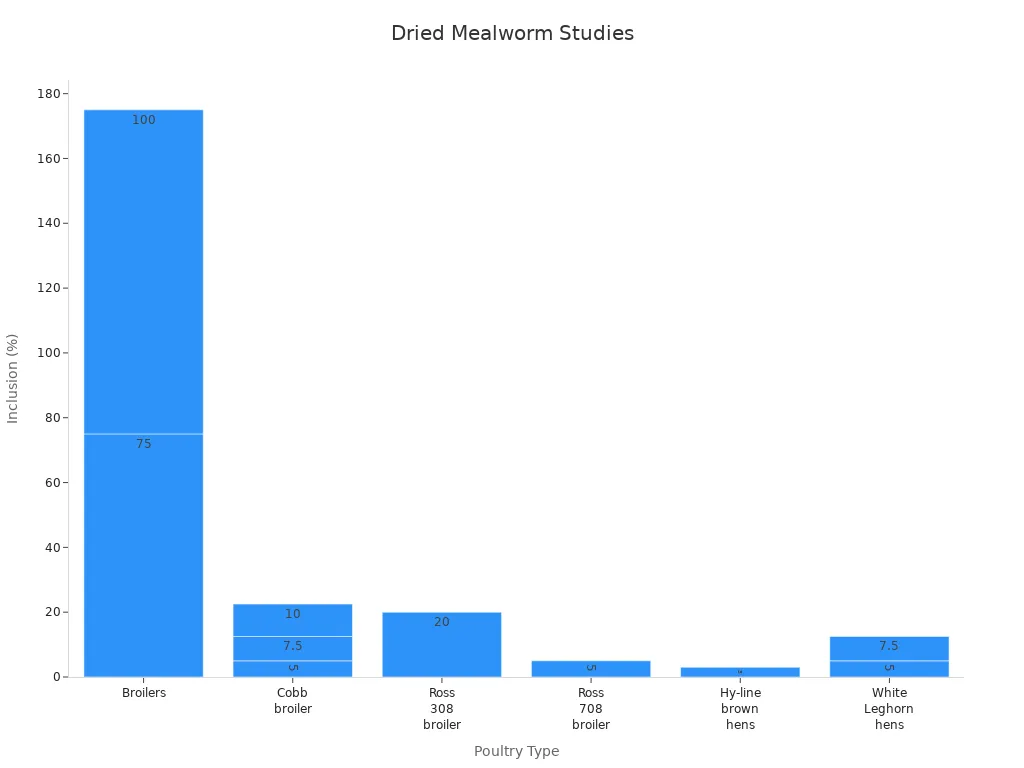
Dried mealworms also avoid the transport and welfare issues that sometimes affect live mealworms. Shipping live insects can lead to high losses from temperature swings or rough handling. Dried mealworms, on the other hand, arrive ready to use and stay fresh longer.
Note: Dried mealworms are a great choice for anyone who feels squeamish about handling live insects. They offer all the benefits with none of the mess.
Feeding Tips and Feeder Types
Offering mealworms for wild birds is easy and fun. Many birds will eat mealworms right from a tray or dish. Some people sprinkle them on the ground or mix them with seeds. Others use special feeders designed just for mealworms. These feeders help keep the mealworms dry and make it harder for larger animals to steal the food.
Researchers have tested different feeder designs to see how wild birds respond. In one experiment, birds faced puzzle-box feeders with mealworms inside. The results showed that between 10.7% and 34.7% of birds could solve a simple puzzle to get the mealworms. More complex feeders saw fewer birds succeed, but many still managed to get a tasty reward. This shows that birds enjoy the challenge and will work for their favorite treat.
Here are some popular ways to offer mealworms:
- Use a shallow dish or tray feeder.
- Try a mesh feeder that lets rain drain away.
- Choose a covered feeder to keep mealworms dry.
- Mix mealworms with other foods like seeds or suet.
Tip: Place feeders in a quiet spot with some cover nearby. Birds feel safer and will visit more often.
Safe Storage and Handling
Proper storage keeps mealworms fresh and safe for wild birds. Dried mealworms, such as Dpat Dried Mealworms, last much longer than live ones and need less care. Studies on storage show a few important points:
- Microbial growth is the main concern during storage. Fresh mealworms start with high microbial counts, so keeping them dry and cool is key.
- Modified atmosphere storage, using gases like CO2 and N2, helps slow down microbial growth.
- For dried mealworms, water activity below 0.60 stops most microbes. Values between 0.20 and 0.40 also reduce browning and spoilage.
- Freeze drying keeps protein and nutrients at their best, but other drying methods like microwave or vacuum drying also work well.
- Refrigerated storage at 4°C can keep mealworm pastes safe for 7 to 14 days before microbial counts reach unsafe levels.
Store dried mealworms in a cool, dry place. Keep the container sealed to block out moisture and pests. This helps preserve their nutritional value and keeps them safe for birds.
Dried mealworms make feeding time simple and safe. They offer a high-energy treat for wild birds and stay fresh for months with proper storage.
Mealworms for wild birds make feeding time simple and fun. Anyone can add them to a feeder and watch birds thrive. With easy storage and feeding tips, people see more colorful birds in their yard. Try mealworms for wild birds and enjoy a lively backyard every day.
FAQ
Do all wild birds eat mealworms?
Most insect-eating birds love mealworms. Bluebirds, robins, chickadees, and wrens visit feeders for them. Some seed-eaters may try them, too.
Tip: Try offering mealworms in a dish to see which birds visit your yard.
How should someone store Dpat Dried Mealworms?
Keep Dpat Dried Mealworms in a cool, dry place. Seal the container tightly. This keeps them fresh and safe for birds.
| Storage Tip | Why It Helps |
|---|---|
| Cool, dry location | Prevents spoilage |
| Sealed container | Blocks moisture, pests |
Can people mix mealworms with other bird foods?
Yes! Many bird lovers mix mealworms with seeds or suet. This attracts more bird species and gives them extra nutrition.
Birds enjoy variety at the feeder. Mixing foods keeps them coming back.


